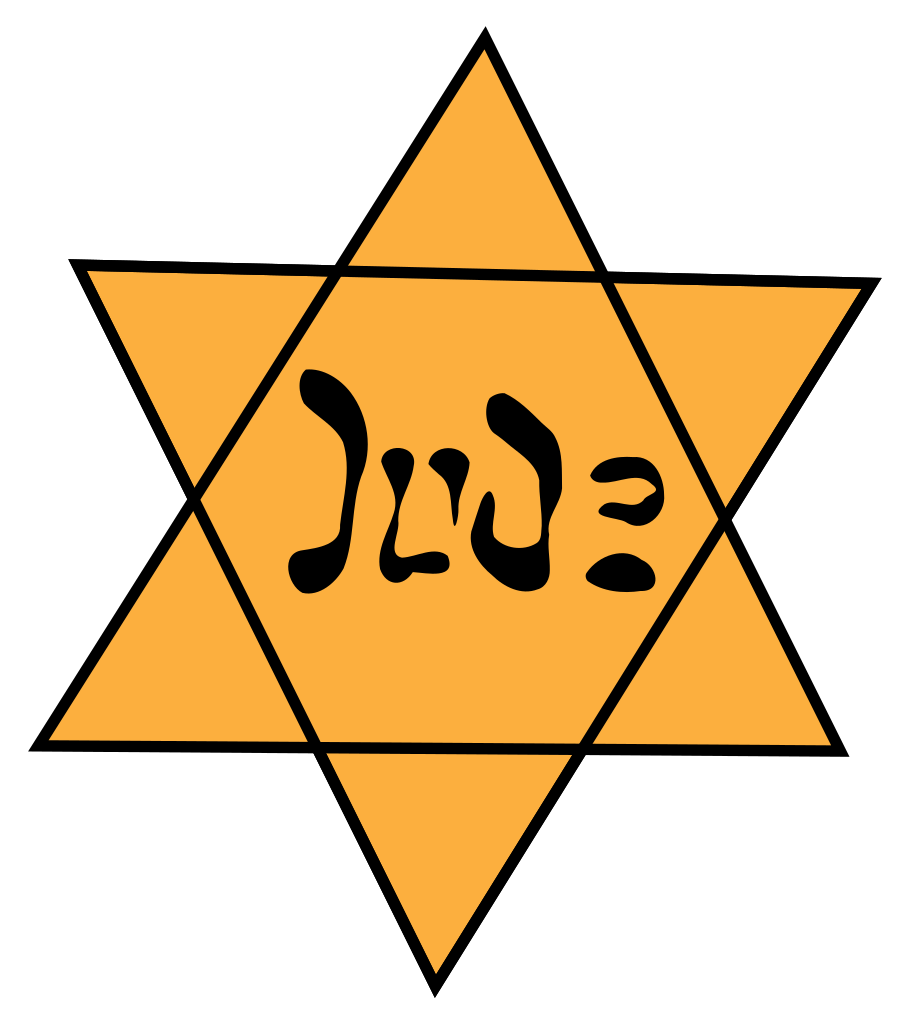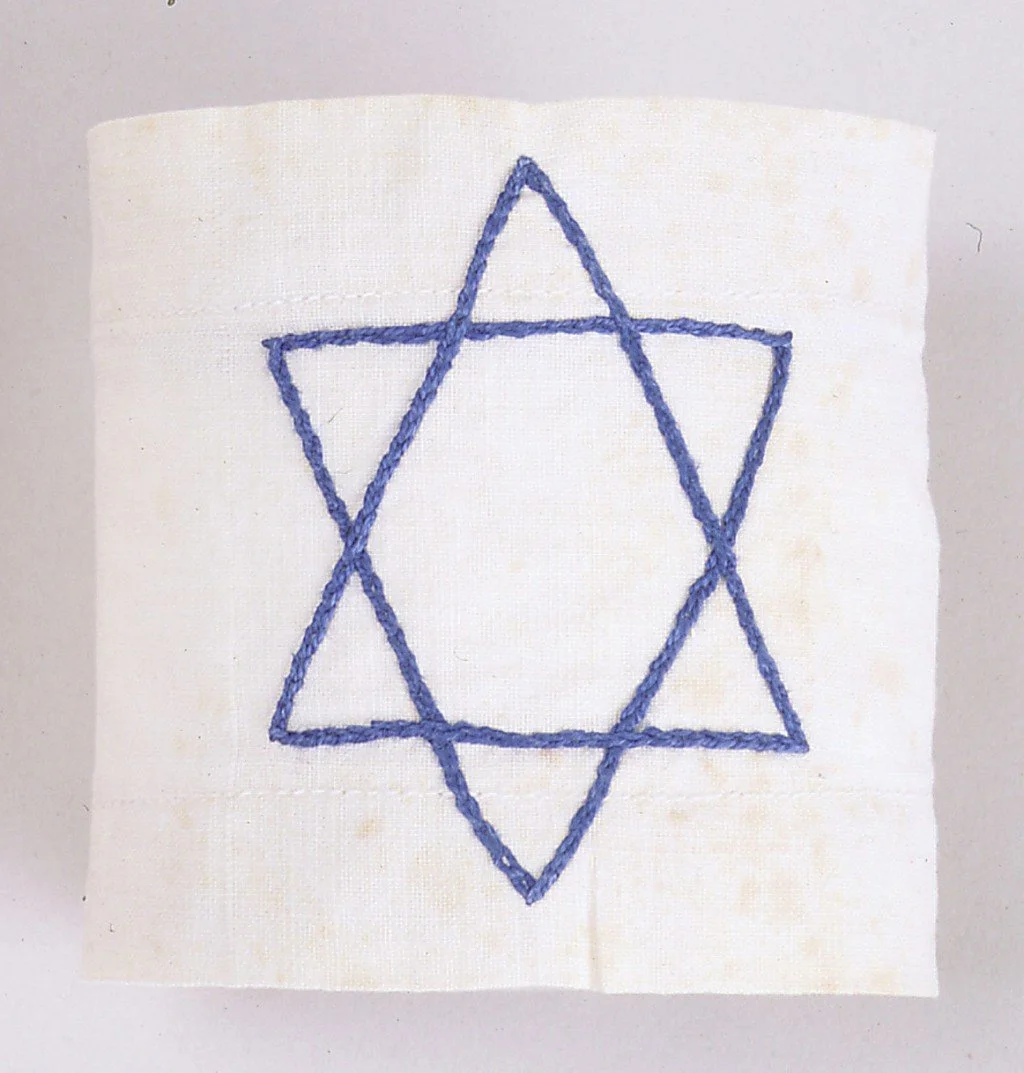
Symbolisation
Nazi officials implemented the Jewish badge (an identifying badge to mark Jews) between 1939 and 1945. They did so in a systematic manner, as a prelude to deporting Jews to ghettos and killing centers in German-occupied eastern Europe.
Under the Nazi regime Jewish people were forced to wear identifiers such as Star of David armbands or badges. The badges were often sewn onto a person’s clothing either on the arm, chest, back, or all of those places. The intention was to isolate, harass, and humiliate Jewish people, and further embedded Nazi ideology that Jewish people were different from everyone else by marking them out from the rest of the population.
All people held in Nazi concentration camps had identifying badges to be displayed on their camp uniforms, from 1938 all Jewish people had to display a yellow Star of David. The Star of David can be made up of two equilateral triangles, if a person was for example both Jewish and homosexual, then the bottom triangle would remain yellow while the top one would be pink to denote both categories.
Hans Frank; Governor General of Nazi occupied Poland, decreed on November 23rd 1939 that all Jewish people over a certain age had to wear a 4 inch wide white armband displaying a blue Star of David on their right arm. Jewish people had to pay for the 'Jewish Stars' and were made responsible for their distribution. Any person who broke the order faced severe punishments such as fines, imprisonment or death. The wearing of identifiers was then gradually spread to all Nazi occupied areas.
The yellow star, inscribed with the word "Jude" ("Jew" in German), has become a symbol of Nazi persecution. Its likeness abounds upon Holocaust literature and materials.
But the Jewish badge was not instituted in 1933 when Hitler came to power. It was not instituted in 1935 when the Nuremberg Laws stripped Jews of their citizenship. It was still not implemented by Kristallnacht in 1938. The oppression and labeling of the Jews by use of the Jewish badge did not begin until after the start of the Second World War. And even then, it began as local laws rather than as a unified Nazi policy.
Whether Nazis Where First to Implement a Jewish Badge
The Nazis rarely had an original idea. Almost always what made the Nazi policies different was that they intensified, magnified, and institutionalized age-old methods of persecution.
The oldest reference to using mandatory articles of clothing to identify and distinguish Jews from the rest of society was in 807 CE. In this year, Abbassid caliph Haroun al-Raschid ordered all Jews to wear a yellow belt and a tall, cone-like hat.1
But it was in 1215 that the Fourth Lateran Council, presided over by Pope Innocent III, made its infamous decree.
Canon 68 declared:
Jews and Saracens [Muslims] of both sexes in every Christian province and at all times shall be marked off in the eyes of the public from other peoples through the character of their dress.
White armband with a Star of David embroidered in blue thread, worn by Dina Offman from 1939 until 1941 while in the ghetto in Stopnica, Poland.
When the Nazis Decided to Re-Use the Jewish Badge
The first reference to a Jewish badge during the Nazi era was made by the German Zionist leader, Robert Weltsch. During the Nazi declared boycott upon Jewish stores on April 1, 1933, yellow Stars of David were painted on windows. In reaction to this, Weltsch wrote an article entitled "Tragt ihn mit Stolz, den gelben Fleck" ("Wear the Yellow Badge with Pride") which was published on April 4, 1933. At this time, Jewish badges had yet even to be discussed among the top Nazis.
It is believed that the first time that the implementation of a Jewish badge was discussed among the Nazi leaders was right after Kristallnacht in 1938. At a meeting on November 12, 1938, Reinhard Heydrich made the first suggestion about a badge.
But it wasn't until after the Second World War began in September 1939 that individual authorities implemented a Jewish badge in the Nazi German-occupied territories of Poland. For instance, on November 16, 1939, the order for a Jewish badge was announced in Lodz.
Jewish Shop windows broken as as result of Kristallnacht 9th November 1938.
How Implementing the Jewish Badge Helped the Nazis
Of course, the obvious benefit of the badge to the Nazis was the visual labeling of the Jews. No longer would the rabble only be able to attack and persecute those Jews with stereotypical Jewish features or forms of dress, now all Jews and part-Jews were open to the various Nazi actions.
The badge made a distinction. One day there were just people on the street, and the next day, there were Jews and non-Jews.
A common reaction was as Gertrud Scholtz-Klink's stated in her answer to the question, "What did you think when one day in 1941 you saw so many of your fellow Berliners appear with yellow stars on their coats?" Her answer, "I don't know how to say it. There were so many. I felt that my aesthetic sensibility was wounded."
All of a sudden, stars were everywhere, just like Hitler had said there were.
Badges in the Camp System
The Germans implemented a complex system of identifying badges for inmates in concentration camps, usually consisting of inverted triangles whose color denoted the category of the prisoner.
Jews incarcerated in camps were marked with two yellow triangles forming a Star of David. View This Term in the Glossary Made of fabric, these were sewn onto camp clothing. Other categories of prisoners were identified by the red triangle (political prisoners), green (criminals), black (asocials), brown (Sinti-Roma, originally black), pink (“homosexual” offenders), among others.
These categories could be further refined by combining them. Thus, a Jew incarcerated for political reasons would have a red triangle superimposed on a yellow triangle. For non-German nationals, a letter denoting the country of origin was placed inside the badge, such as a P for Polish prisoners.
A chart of prisoner markings used in German concentration camps. Dachau, Germany, ca. 1938–1942.
Beginning in 1937–1938, the SS created a system of marking prisoners in concentration camps. Sewn onto uniforms, the color-coded badges identified the reason for an individual’s incarceration, with some variation among camps. The Nazis used this chart illustrating prisoner markings in the Dachau concentration camp.
How the Badge Affected Jews
At first, many Jews felt humiliated about having to wear the badge. As in Warsaw:
"For many weeks the Jewish intelligentsia retired to voluntary house arrest. Nobody dared to go out into the street with the stigma on his arm, and if compelled to do so, tried to sneak through without being noticed, in shame and in pain, with his eyes fixed to the ground."
The badge was an obvious, visual, step back to the Middle Ages, a time before Emancipation.
But soon after its implementation, the badge represented more than humiliation and shame, it represented fear. If a Jew forgot to wear their badge they could be fined or imprisoned, but often, it meant beatings or death. Jews came up with ways to remind themselves not to go out without their badge.
Posters often could be found at the exit doors of apartments that warned Jews by stating:
"Remember the Badge!" Have you already put on the Badge?" "The Badge!" "Attention, the Badge!" "Before leaving the building, put on the Badge!"
But remembering to wear the badge was not their only fear. Wearing the badge meant that they were targets for attacks and that they could be grabbed for forced labor.
Many Jews attempted to hide the badge. When the badge was a white armband with a Star of David, men and women would wear white shirts or blouses. When the badge was yellow and worn on the chest, Jews would carry objects and hold them in such a way as to cover their badge. To make sure that Jews could be easily noticed, some local authorities added additional stars to be worn on the back and even on one knee.
But those weren't the only rules. And, actually, what made the fear of the badge even greater were the other innumerable infractions for which Jews could be punished. Jews could be punished for wearing a creased or folded badge. They could be punished for wearing their badge a centimeter out of place. They could be punished for attaching the badge using a safety pin rather than sewing it onto their clothing.
The use of safety pins was an effort to conserve badges and yet give themselves flexibility in outfits. Jews were required to wear a badge on their outer clothing — thus, at least on their dress or shirt and on their overcoat. But often, the material for badges or the badges themselves were scarce, so the number of dresses or shirts that one owned far exceeded the availability of badges. In order to wear more than one dress or shirt all the time, Jews would safety pin a badge onto their clothing for easy transfer of the badge to the next day's clothing. The Nazis did not like the practice of safety pinning for they believed it was so the Jews could easily take off their star if danger seemed near. And it very often was.
Under the Nazi regime, Jews were constantly in danger. Up to the time when Jewish badges were implemented, uniform persecution against the Jews could not be accomplished. With the visual labeling of Jews, the years of haphazard persecution quickly changed to organized destruction.
Why Nazis Made Jewish People Wear Yellow Stars | Compilation | USC Shoah Foundation






